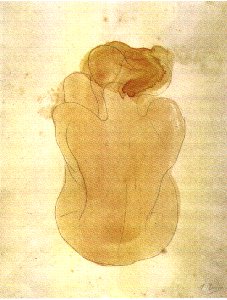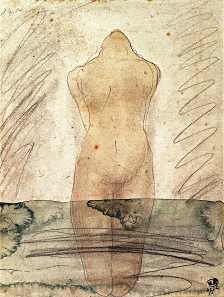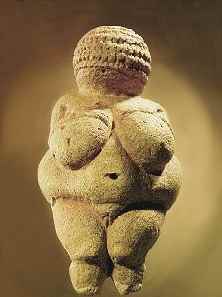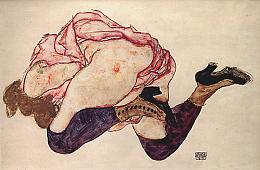H. de Roos - Rodin´s Approach to Art |
|
19. Woman as a Vase: the transformation of Nature to Culture |
|
In his article on Rodin´s late drawings and watercolours, J.A. Schmoll draws attention to a particular series of drawings . The first sketch shows a frontal view of a kneeling female nude, her arms bent backwards. In the second coloured drawing, the model has stretched her head backwards as well. Only the line of the chin remains visible, so that the shape of her body resembles a Greek amphora. In the final version, Rodin has added sketched ornaments to decorate the resulting vase shape.
In his conversation with Gsell, Rodin refers to still another variation, a view from the back: |
Femme nue assise et de dos, 1899 |
"In short, Beauty is everywhere. It is not she that is lacking to our eye, but our eyes which fail to perceive her. Beauty is character and expression. Well, there is nothing in nature which has more character than the human body. In its strength and its grace it evokes the most varied images. One moment it resembles a flower (...). At another time it is an urn. I have often asked a model to sit on the ground with her back to me, her arms and legs gathered in front of her. In this position the back, which tapers to the waist and swells at the hips, appears like a vase of exquisite outline. In the German version, this remark about the "vase-woman" is set forth: "... appears like a vase of exquisite outline, an
amphora, that carries the future life in her womb"
Schmoll points out these drawings illustrate one of Rodin´s favourite ideas, the “metamorphosis of the female body into a vase”. In Rodin´s Art, the female figure develops into a cult object indeed. But also the reverse interpretation would be valid: that all Culture is actually derived from Nature.
Woman as a vase, Rodin Venus of Willendorf The kneeling woman Rodin drew not only shows resemblance to a Greek amphora. The female figure without face nor feet, the breasts and belly protruding, shows a fasconating formal similarity to the little statue of Venus of Willendorf, the world’s oldest sculpture (35,000 years B.C.). In her book Sexual Personae, the American author Camille Paglia describes this figure as the eternally pregnant symbol of fertility, representing an archaic earth-cult that has not developed visual criteria of beauty and elegance yet:
The Venus of Willendorf, a cult-image half-molded from a rough stone, is unbeautiful because art has not yet found its relation to the eye. Her fat is symbol of abundance in an age of famine. She is the too-muchness of nature, which man longs to direct to his salvation. (...) Venus of Willendorf represents the obstacle of sex and vegetable nature.
(...) In the west, art is hacking away at natures excess. The western mind makes definitions. That is, it draws lines. This is the heart of Appolianism. There are no lines in the Venus of Willendorf, only curves and circles. She is the formlessness of nature. She is mired in the miasmic swamp I identify with Dionysos.
Although we do not know if Rodin ever heard of this pre-historic figure, found on 7 August 1908 in Austria, or even knew how it looked like, Paglia´s view on Western Art provokes some interesting associations. For Rodin, obviously, Nature is best represented by the human body, especially the female body. The anonymous Vase-Woman is not a particular women: she stand for all women. She represents fertility, gives birth to life, to the whole world. By reducing her shape to a faceless silhouette, outlined by pencil, the artist not only illustrates the transition to a cultural product: the act of drawing itself transforms Nature to Culture, domesticates the chthonic, Dionysian wildness of female sexuality, subjects it to the male eye, the male will. Instead of enforcing Appolian strictness, Rodin´s erotic sketches seem to oscillate with the casual voluptuousness of his models – quite different, for example, from the haunted nudes Egon Schiele (1890-1918) scratched into the paper during the same period. |
|
|
Egon Schiele: Kneeling Woman with Head |
In Albert Elsen's opinion, Schiele had used Rodin's technique of "continuous drawing," which would account for a visceral and intuitive style. But as pointed out by Lee Siegel in The Atlantic - and can be seen quite easily from the drawings themselves - Schiele´s line is angular, nervous, cerebral; his drawings are cruel, his figures look lacerated, their skin flayed. Both in his stroke and in his coloring, Schiele seems to have worked in a completely other way than Rodin: neither Appolinian, nor Dyonisian, but narcissistic.
|
|
|
|
|
Notice:
Museum logos appear only as buttons linking to Museum Websites and do not
imply any |
|



